Damp and Condensation Problems
with houses built
from the 1930's to 1950's
Defects Report to find the cause and effect of the dampness and condensation
 Dampness or condensation in a property of this age is a common problem. As Building Surveyors we can carry out a Specific Defects Report to find the cause of the dampness, which is causing the effect within the house.
Dampness or condensation in a property of this age is a common problem. As Building Surveyors we can carry out a Specific Defects Report to find the cause of the dampness, which is causing the effect within the house.
Quick Survey Quote
Get a Quick Quote or Free Phone 0800 298 5424 for speak to a surveyor.
Problems with houses built between 1930's and 1950's
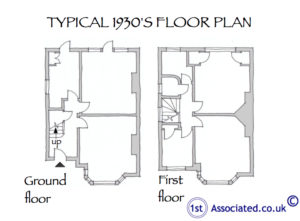
We are often asked to carry out defect reports on houses built from the 1930's to the 1950's. These problems relate to damp and condensation and thermal efficiency. We are particularly finding these problems where the original building is being extended or altered. This could be a single storey rear extension, a two storey extension or a loft conversion/extension. When we carry out these defect reports we utilise a variety of instruments including
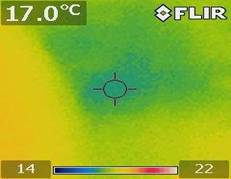
1. Thermal imaging cameras
2. Gann resistance meters
3. Surface temperature readers
4. Relative humidity readers
5. Data collectors
Please feel free to phone us for a chat on Free Phone 0800 298 5424. As we are Independent Surveyors we also carry out Building Surveys as well as Structural Surveys and Specific Defects Reports which can incorporate elements of thermal efficiency if so requested.
Free phone 0800 298 5424
Problems with 1930's to 1950's houses
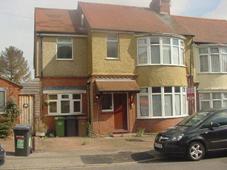
The basic problem with this era of house is that we are trying to live in a house that was built in the 1930's to the 1950's in a modern way and as such we have modern requirements of the house. It was a very different world when the houses were originally built, during or at the end of the War Years, and basic considerations such as being able to source the right materials to build the houses were upmost in the developers, architects and builder's minds. The houses were very much the best that could be built during this time and the fact that we are still living in them is testament to how well they were built. However we are now having problems with them while living in and using them in a modern way.
What does a 1930's, 1940's or 1950's building look like?
In this era of property roundish bays, usually without foundations, were very popular as was the use of vertical clad tiling and also originally the use of metal windows (single glazed of course as we had not thought of double glazing at the time). Just by mentioning these few things you can start to appreciate the type of problems that we have with 1930's to 1950's properties today.
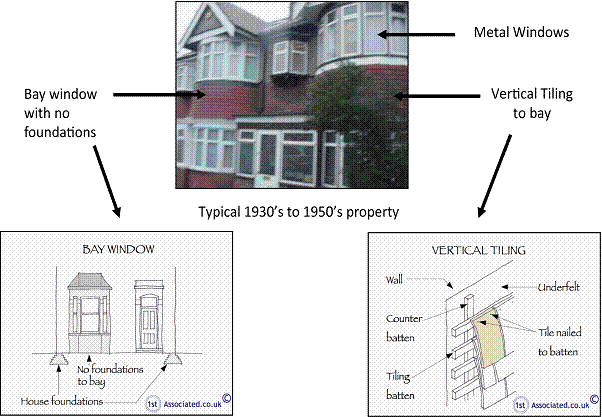
Windows in 1930's, 1940's and 1950's Properties
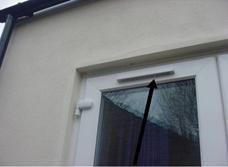
Many metal single glazed windows have now been replaced with plastic double glazed windows, with and without trickle vents.
The reason the metal windows were replaced was that many people became very fed up with these windows as they were prone to considerable condensation. This is because as the warm air came in contact with the cold metal of the window condensation occurred.
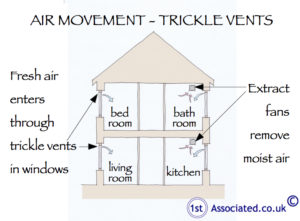
At first new double glazing was made using Aluminium and some of these may still be around in properties from the 1930's, 1940's and 1950's. Although these were a great step forward they still created a lot of condensation because of the problems with the coldness of the metal.
After this we progressed onto plastic windows, which were of poorer quality and had a limited life. Modern plastic windows now have trickle vents as we have decided to add ventilation back into the windows to help reduce the problems with humidity. More about humidity in a second!
Bay Windows to 1930's, 1940's and 1950's Properties
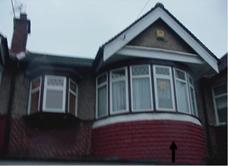
As mentioned earlier another popular feature of this era of property was the semi-circular bay window which developed from previous eras and generations of windows such as the Victorian and Edwardian. These were lightweight, usually without foundations and sometimes clad with vertical tiling They would also originally have been built with next to no insulation but may have had insulation added later.
Is your rising damp really humidity and condensation?
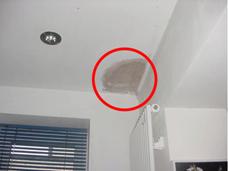
A lot has been said about rising damp. Many property owners, when looking at buying a property, are put off if, after having a survey carried out, they hear there is rising damp. A very big problem with rising damp is that it is often not actually rising damp at all. It can be anything from leaking gutters to capillary action caused by render bridging the original damp proof course or humidity within the building.
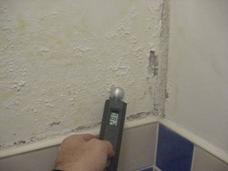
Recently one of our Building Surveyors looked at a building that had a variety of damp patches. Not only that but when we tested the walls using an electronic resistance meter known as a Gann meter (used to check the amount of dampness within a wall) we found that there was more damp in some walls but where visible signs were not showing through, for example, there was cold bridging. More about cold bridging later!
However, our point is, just because there is dampness in a property it doesn't mean there is rising damp. The world is full of people keen to cure your rising damp when in fact it isn't rising damp at all. Just have a think before you call the damp specialist as often they will not understand when it's a condensation or humidity problem.
|
|
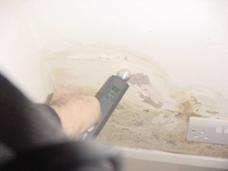 |
|
Damp patch half way up the wall |
Damp patch at the bottom of the wall |
What makes us think it's a humidity problem?

We think this because we see many damp buildings. In fact of late we have been seeing damp problems every week. We tend to find that the older buildings that were designed before insulation was thought about and traditionally get rid of water by drawing it in then releasing it gradually, known as breathing, can no longer cope with the amount of humidity in the air.
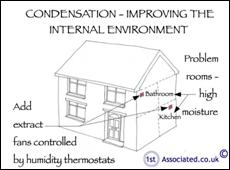 With everyone showering everyday, usually without turning on the extractor fans, then humid air condenses on colder areas such as corners of walls, high and low level, and within cupboards. We suggest you move back any bookcases, sofas etc. that you have against a wall to see if there are any signs of mould behind it, often you will find there is. These colder areas with lack of air movement are susceptible to black mould.
With everyone showering everyday, usually without turning on the extractor fans, then humid air condenses on colder areas such as corners of walls, high and low level, and within cupboards. We suggest you move back any bookcases, sofas etc. that you have against a wall to see if there are any signs of mould behind it, often you will find there is. These colder areas with lack of air movement are susceptible to black mould.
What is Cold Bridging? We heard it's a problem
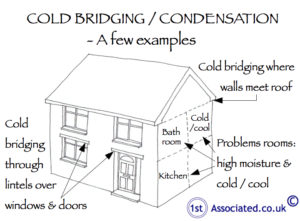 We mentioned earlier that cold bridging can also be a problem. This is a problem with the construction of 1930's to 1950's buildings as they have elements that allow the cold to pass through them. Predominantly we have found that in first floor bedrooms that have walls, roofs and ceilings (as you would expect) there is also an angular section that forms part of the room that is also the roof.
We mentioned earlier that cold bridging can also be a problem. This is a problem with the construction of 1930's to 1950's buildings as they have elements that allow the cold to pass through them. Predominantly we have found that in first floor bedrooms that have walls, roofs and ceilings (as you would expect) there is also an angular section that forms part of the room that is also the roof.
Interestingly, if you thermal imaged this area the angle of the wall is blue, meaning that is it cold. Equally if you take thermal images of windows you can often find a cold lintel above, perhaps a concrete lintel. These areas absorb the cold and they also get condensation on them when the warm moist air is drawn towards them.
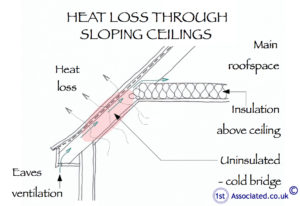 |
 |
|
Sloping ceiling
|
A thermal image of the walls and the ceiling. The blue shows that the ceiling is cold where it's part of the roof |
A modern extension on your 1930's, 1940's or 1950's house can cause dampness
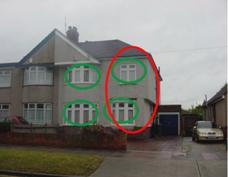
Often there is very little consideration given to how a house works and how it will work when old and new construction come together. This can result in dampness approximately where the two constructions meet. The two buildings work very differently, the modern one having a cavity wall and usually dry lining and the older building having solid walls often in Flemish Bond brickwork or possibly even render
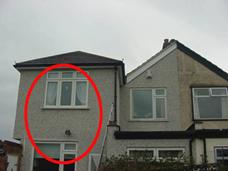 |
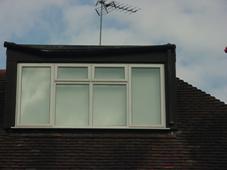 |
|
1930's property extended to the rear |
1950's property roof conversion |
Modern render and paints can cause dampness
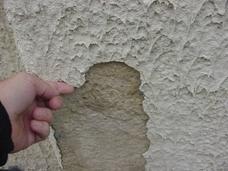
We have seen modern renders and modern paints cause problems. We term them as plastic or polymer paints and these are paints that seal a building.
Ironically, these paint and render finishes are advertised as maintenance free when unfortunately they are often a contributory fact towards dampness in a building.
No simple answer to black mould
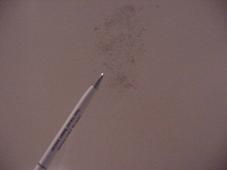
Unfortunately, we would say that the jury is still out and we are still learning and understanding how buildings work when they are super insulated, which is what we are doing today with our houses. We are producing airtight boxes in which any heat that is created stays in there for a long time.
This works where the whole building is new but where it is part old and part new we find it tends to have problems.
Has this article given you food for thought with regard to condensation, humidity and black mould and rising damp (that may not be rising damp)?
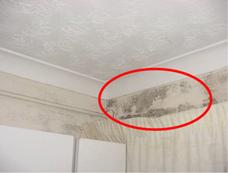
We hope this article has opened your eyes to condensation, humidity and black mould.
We believe this is a big problem and can have effects on your health and is generally not a good environment to live in. If you can possibly change it or improve it then you should.
Independent Building Surveyors
We are Independent Building Surveyors, which means we are not affiliated to any bank, building society or estage agent and can therefore act only for you in your best interests and not the interests of another company.
All of our Surveyors are Chartered and are Members of the Royal Institution of Chartered Surveyors - RICS and Members of the Independent Surveyors and Valuers Association - ISVA.
Please free phone 0800 298 5424 for a chat about dampness.
Please be aware that we may not talk about rising damp or indeed think it is rising damp but we will solve your problem. A defects report on dampness can form part of a wider report of a structural survey or a building survey on the whole house. It is often far better to look at the whole house as you get a complete picture of how to improve things. We can also look at the most cost efficient and most cost effective way of improving the house that you are looking to buy.
All rights reserved to 1stAssociated.co.uk
All rights are reserved the contents of the website are not to be reproduced or transmitted in any form in whole or part without the express written permission of www.1stAssociated.co.uk
